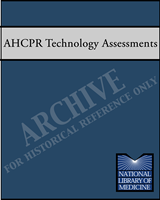From: Lung-Volume Reduction Surgery for End-Stage Chronic Obstructive Pulmonary Disease

AHCPR Health Technology Assessments.
Rockville (MD): Agency for Health Care Policy and Research (US); 1990-1999.
NCBI Bookshelf. A service of the National Library of Medicine, National Institutes of Health.